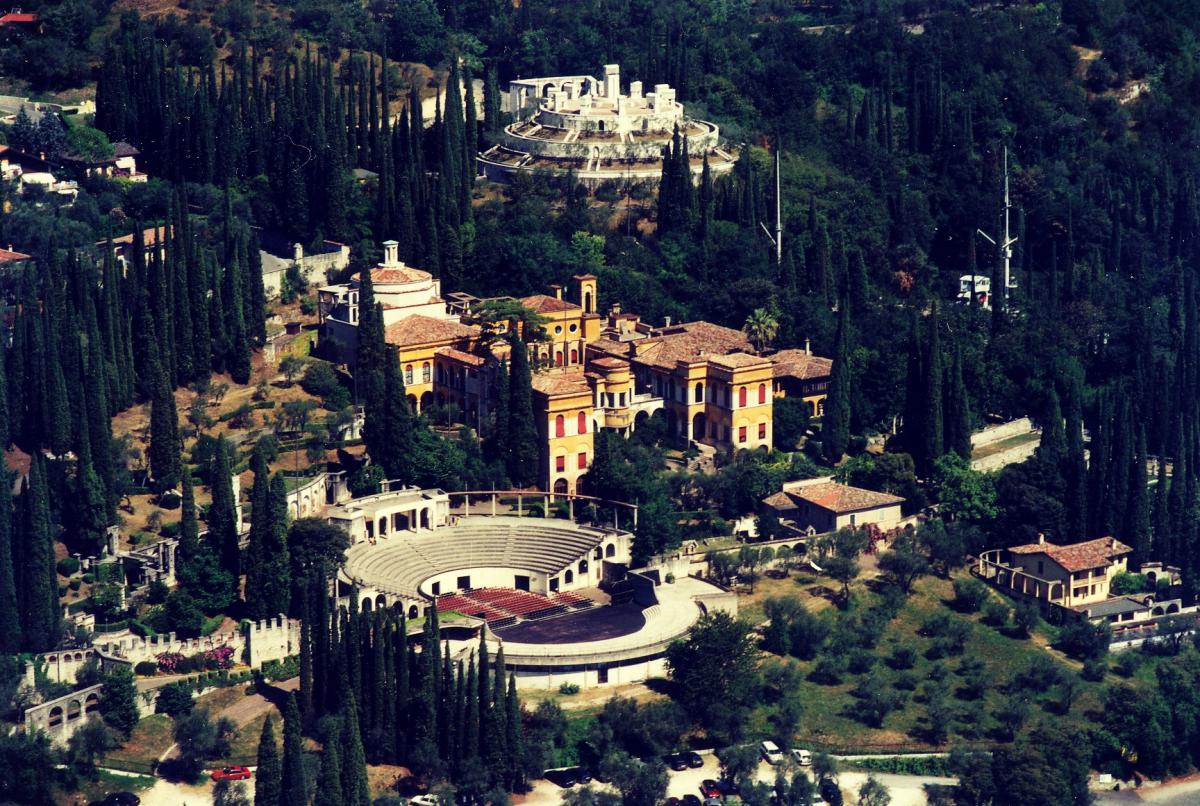




 31 January 2016
31 January 2016
 Caterina Pomini
Caterina Pomini
 14973
14973
“I am a better interior decorator and upholsterer than I am a poet, novelist or soldier” Gabriele D'Annunzio
Set on the hills of Gardone Riviera, about halfway between Milan and Padua, Il Vittoriale degli Italiani (The Shrine of Italian Victories) was once the residence of Gabriele D'Annunzio, one of the greatest Italian writers and also a very influential and controversial figure. Just consider that the renovation of his massive estate was funded by the National Fascist Party in order to keep the writer away from political life in Rome. D'Annunzio lived in the Prioria (the main villa) until he died on March 1, 1938; between 1921 and 1955, the Vittoriale underwent considerable expansion and was finally transformed into the “monumental citadel” you see today, an odd-looking fairground that includes a war museum, an auditorium, a biplane (the one that flew over Vienna in 1918), the bow of the Puglia battleship, a mausoleum, the poet's cars and a marvellous garden which covers about 50% of the area. Gabriele D'Annunzio's earthly remains lie in the circular mausoleum, along with those of other legionnaires who took part in the Fiume expedition, at the highest point of the estate.
Gabriele D'Annunzio arrived in Gardone Riviera in February 1921 and rented Villa Cargnacco, which had belonged to the illustrious art historian Henry Thode. The villa was officially purchased by the writer in October and – in November – reconstruction started under the guidance of young architect Giancarlo Maroni. The villa consists of about twenty rooms and boasts a library with 33.000 books of Italian literature, French literature, history, art, rare and antique editions. All rooms are immersed in semi-darkness as D'Annunzio suffered from photophobia and was unable to tolerate bright light. Among the many extraordinary rooms, the Music Room stands out for its black and gold damask wall hanging tapestries, which were chosen to improve acoustics and encourage reflection; Leda's Room (the writer's bedroom) takes its name from a plaster sculpture depicting the myth of Leda – daughter of Thestius and wife of Tyndareus – who was seduced by Zeus in the form of a swan.
Other splendid rooms, all rich in symbolism, are:
the Blue Bathroom – literally filled with an unbelievable amount of objects such as plaques, vases and majolica plates.
The Leper's Room – conceived as meditation space and embellished by the bed of two ages – a cradle/coffin-shaped bed.
The Room of the Stump – a small studio on the upper floor where D'Annunzio handled his mail.
The Zambracca Room – the dressing room in which he was found dead on March 1, 1938.
The Officina – his workshop, where he spent most of the day.
The Cheli's Room – the dining room named after his giant tortoise that died in the garden from tuberose indigestion.
The War Museum is housed within the art nouveau Schifamondo Palace (meaning “escape from the world”) the new wing of the Villa which was nearing completion after many years when the poet died. The palace was conceived as an ocean liner, with portholes, alabaster stone windows, wood walls, high ceilings, narrow hallways and a studio resembling a pilothouse.
In conclusion, the Gardens have substantive environmental and historic significance and feature pergolas, garden terraces, old-style conservatories, an amphitheatre (still used for performances today), fountains and meditation areas. Let us say that the Vittoriale is an Italian wonder which is definitely worth visiting!
The Vittoriale is open all year round with the exception of December 24th, Christmas Day and January 1st; you can visit it independently or take a guided tour. For further information, you can always see the official website. Interesting in-depth articles about Gabriele D'Annunzio and his weird, unrivaled home are: Il Vittoriale: A lakeside fantasy fit for a libertine and D'Annunzio and Il Vittoriale Degli Italiani: A Poet’s Fantasy -
THIS SECTION
IS UNDER CONSTRUCTION